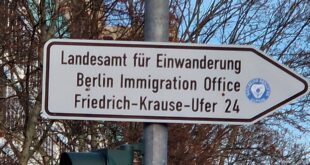Almost a quarter of the people living in Germany last year have an immigration history. That is 20.2 million people or 24.3 per cent of the total population, the Federal Statistical Office said on Thursday in a micro census data report.
The authorities defined people with an immigration history as those who arrived in Germany since 1950 and their direct descendants, the so-called “second generation”.
Compared to the previous year, the number of people with an immigration history increased by 6.5 per cent or 1.2 million persons. Refugee migration played a significant role, especially due to the war in Ukraine.
The number of self-immigrants increased by 7.3 per cent due to refugees mainly from Ukraine, Syria and Afghanistan and thus more strongly than the number of direct descendants of immigrant parents born in Germany, which increased by four per cent.
According to the Federal Statistical Office, a total of 6.1 million people have immigrated to Germany since 2013 – which makes up just under 40 percent of the self-immigrants living here.
The three most common countries of origin of immigrants since 2013 are Syria with a share of 16 percent, Romania with seven percent and Poland with six percent. Ukraine is in fourth place with five per cent.
However, the micro census has not yet fully recorded those who fled Ukraine last year since the Russian attack, it said.
The most important reason for immigration since 2013 has been flight, asylum and international protection with a share of 27.9 percent. This was closely followed by immigration for employment with a share of 24.2 per cent and due to family reunification with a share of 23.9 per cent. Slightly more than eight per cent of those who had immigrated since 2013 had come to Germany primarily for study, education or further training.
The proportion of people with a migration background in the German population is even higher. Last year, it accounted for 28.7 per cent or 23.8 million inhabitants. According to the definition of the Federal Statistical Office, a person has a migration background if he or she or at least one parent was not born with German citizenship.
More than half of the 12.2 million Germans with a migration background have had German citizenship since birth. They are said to have a migration background because at least one parent is foreign, naturalised, German by adoption or a late repatriate.
People without German citizenship make up 48.8 per cent of all persons with a migration background and almost one sixth of the total population.
Femi Awoniyi
 THE AFRICAN COURIER. Reporting Africa and its Diaspora! The African Courier is an international magazine published in Germany to report on Africa and the Diaspora African experience. The first issue of the bimonthly magazine appeared on the newsstands on 15 February 1998. The African Courier is a communication forum for European-African political, economic and cultural exchanges, and a voice for Africa in Europe.
THE AFRICAN COURIER. Reporting Africa and its Diaspora! The African Courier is an international magazine published in Germany to report on Africa and the Diaspora African experience. The first issue of the bimonthly magazine appeared on the newsstands on 15 February 1998. The African Courier is a communication forum for European-African political, economic and cultural exchanges, and a voice for Africa in Europe.






























